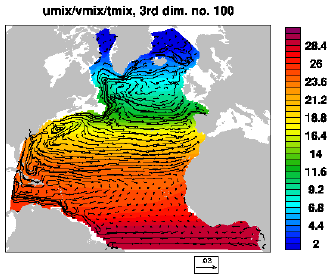shell scripts:
v-on-c.sh
Syntax
Example: Mixed layer current and temperature
The figure below was made by copying the file userdef.ncl from /home/arnem/lib/ncl-metno/ , with the contents of three lines changed to
v1= 2. ; Low value for isopleths, disregarded when nv is 0 or 1 v2= 30. ; High value for isopleths, disregarded when nv is 0 or 1 nv= 35 ; No. of isopleths, there will be nv+1 colors
in order to specify the use of contours and colors. Furthermore, an extended color map was set by editing the contents of two additional lines on the same file, to
;mapname=;"LR BkBlAqGrYeOrReViWh200" ; rainbow style, nv <= 17 mapname="HR BkBlAqGrYeOrReViWh200"; rainbow style, nv <= 35
(In ncl, a semicolon [;] is the start of a comment field that extends to the end of the line.) Then, the following command was issued:
v-on-c.sh 3dmap hycom_031_uv.nc hycom_031_TS.nc umix vmix tmix 100

v-on-c.sh: syntax
v-on-c.sh --help
v-on-c.sh / ncl-metno 1.2
>>>
>>>
>>> Syntax:
>>> =======
>>>
>>> v-on-c.sh <option> <uvfile> <varfile> <u> <v> <var> [<d3node> (<d4node>)]
>>> where
>>> <option> specifies dimensions and geo- or nongeo-grid
>>> implemented:
>>> [234]d - [234]D fields
>>> [234]dmap - [234]D fields, dims. are lon & lat
>>> ...[234]dmap will be displayed on a geogr. map
>>> <uvfile> name of the netcdf file w/ <u> and <v>
>>> <varfile> name of the netcdf file w/ <var>
>>> you may type '.' if <uvfile> & <varfile> are the same
>>> <u> name of variable w/ velocity in the x-direction
>>> on the netcdf file (case sensitive)
>>> <v> name of variable w/ velocity in the y-direction
>>> on the netcdf file (case sensitive)
>>> <var> name of variable to base filled contours on
>>> on the netcdf file (case sensitive)
>>> NOTE! This script requires the same dimensions for
>>> <u>, <v> and <var>, i.e., they must all be
>>> 2d, or 2dmap, etc.
>>> <d3node> node no. of third dimension
>>> if <option> is one of 2d, 2dmap and a fourth
>>> argument is present, or if <d3node> is negative,
>>> this will be interpreted as a flag that will cause
>>> the ncl script to remain (see examples below)
>>> <d4node> node no. of fourth dimension
>>>
>>> The script will produce an eps-file and a png-file.
>>>
>>>
>>> User specifications:
>>> ====================
>>>
>>> By copying the default spec.s from
>>> /home/arnem/lib/ncl-metno/userdef.ncl
>>> to the directory where the command 'v-on-c.sh' is given,
>>> the user may specify
>>> * title
>>> * font
>>> * zooming
>>> * vector spec.s (size, distance, curly/regular vectors)
>>> * color map (palette)
>>> * no. of colors
>>> * plot size limits
>>> for geographical maps:
>>> * names of longitude & latitude variables
>>> * map projection
>>> * coastline detail level
>>> (look up, or copy, this file to edit your own 'userdef' file).
>>>
>>>
>>> Examples:
>>> =========
>>>
>>> v-on-c.sh 4dmap uv.nc hydrography.nc u v temp 1 10
>>> will produce vectors on top of filled contours for
>>> temperature, on a lon-lat grid w/ a map, of the first node
>>> in the third dimension (usually the top vertical level)
>>> and the tenth node in the fourth dimension (ususally time
>>> step no. 10) based on variables
>>> 'u' and 'v' on the file 'uv.nc', and
>>> 'temp' on 'hydrography.nc'
>>> v-on-c.sh 3d surface.nc . u-vel v-vel ssh -1
>>> will produce vectors on top of filled contours for
>>> sea surface height, on a x-y grid of the first node in
>>> the third dimension, based on variables 'u-vel', 'v-vel'
>>> and 'ssh' on the file 'surface.nc'; and the ncl script
>>> will be retained
>>> v-on-c.sh 2dmap ave.nc topography.nc ubaro vbaro topo a
>>> will produce vectors on top of filled contours for
>>> the bottom topography, on a lon-lat grid w/ a map,
>>> based on variables
>>> 'ubaro' and 'vbaro' on the file 'ave.nc', and
>>> 'topo' on 'topography.nc';
>>> the ncl script will be retained
>>>
>>>
>>> Terminating.